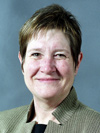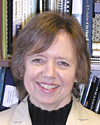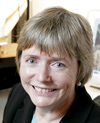Number 52 • July/August 2006
Contents
Susan Perry Appointed CLIR Interim President
Surveying the E-Journal Archiving Landscape by Kathlin Smith
Carole Moore and Karin Wittenborg Named to CLIR Board
Oxford University Joins Digital Library Federation
DLF and OCLC Launch Registry of Digital Masters Public Interfaceby Barrie Howard
Abe Crystal Receives A. R. Zipf Fellowship
Humanists Receive Library Fellowships
The Future of Bibliographic Control
Susan Perry Appointed CLIR Interim President
 ON JULY 1, Susan Perry began her tenure as CLIR interim president. She succeeds Nancy Davenport, who stepped down as president June 30.
ON JULY 1, Susan Perry began her tenure as CLIR interim president. She succeeds Nancy Davenport, who stepped down as president June 30.
In announcing the appointment on June 8, CLIR Board Chairman Charles Phelps said, “We feel very fortunate that Ms. Perry has agreed to lead CLIR as the Board continues its search for a permanent president. Her energy, ability, and years of experience with CLIR, as well as her reputation in the field, will serve the organization well in the months ahead.”
Ms. Perry has served as director of programs at CLIR since 2001. While at CLIR, she has served as co-dean of the Frye Leadership Institute and as staff officer for the Academic Librarians Advisory Committee, the CLIR Chief Information Officers Group, and the initiative for workflow restructuring. Ms. Perry has simultaneously served as a senior adviser to The Andrew W. Mellon Foundation, working on a range of initiatives for library and information technology services in liberal arts colleges.
Before joining CLIR, Ms. Perry was director of library, information, and technology services at Mount Holyoke College.
“I am honored to be asked to lead the staff during this transition,” said Ms. Perry, “and to support the fine work CLIR has done over the years in serving as a catalyst for moving library, information, and scholarly communication issues forward.”
The CLIR Board is currently accepting applications for the permanent position. A job description is available at https://www.clir.org/news/president.html.
Surveying the E-Journal Archiving Landscape
by Kathlin Smith
THE GROWTH OF e-journal publication and users’ increasing dependence on electronic resources poses an urgent question to institutions of higher education: how can we ensure the long-term availability of e-journal content for future access?1 A forthcoming report from CLIR, E-Journal Archiving Metes and Bounds: A Survey of the Landscape, will help libraries better understand the emerging strategies and options for electronic archiving and enable them to determine their best courses of action. The study describes a range of preservation initiatives currently under development for peer-reviewed journal literature and assesses the potential and vulnerabilities of each.
The Cornell University Library Research and Assessment Services wrote the report, which CLIR commissioned in collaboration with the Association for Research Libraries (ARL).
Comparing Programs
The bulk of the report describes, contrasts, and compares 12 of the most promising preservation programs: the Canada Institute for Scientific and Technical Information (CISTI), Controlled Lots of Copies Keep Stuff Safe (CLOCKSS), LOCKKS Alliance, OCLC Electronic Collections Online (ECO), OhioLINK Electronic Journal Center (EJC), The National Library of the Netherlands’ KB e-Depot, Germany’s KOPAL, Los Alamos National Lab Research Library (LANL-RL), Ontario Scholars Portal, Preserving and Accessing Networked Documentary Resources of Australia (PANDORA), Portico, and PubMed Central.
The Cornell study team interviewed principals at each of these programs to learn about their technical functions, business practices, content and coverage, access policies, and relations with publishers, as well as the responsibilities a library would assume if it engaged with the program.
The 12 programs fall into three distinct organizational types:
- consortia that aggregate content primarily for access purposes but have assumed archiving responsibility (OCLC’s ECO, OhioLink, and Ontario Scholars Portal);
- member/subscriber initiatives, launched specifically to address preservation issues (Portico, LOCKKS Alliance, and CLOCKSS); and
- government-supported efforts (the largest category, comprising the remaining six programs).
To help readers identify the potential benefits and drawbacks of each of the 12 programs for their own institutions, the authors compare them in the context of seven minimal criteria for e-journal archiving programs2:
- The repository has both an explicit mission and the necessary mandate to perform long-term e-journal archiving.
- Rights and responsibilities associated with preserving e-journals are clearly enumerated and remain viable over long time frames.
- The repository is explicit about which scholarly publications it is archiving and for whom they are being archived.
- E-journal archiving programs are assessed on the basis of their ability to meet a minimal set of well-defined services.
- The repository negotiates with publishers to ensure that the digital preservation program has the right and expectation to make preserved information available to libraries under certain conditions.
- The repository is organizationally viable.
- The repository is part of a network.
Identifying Gaps in Coverage
A comparison against these criteria reveals gaps in both criteria and coverage. No single source preserves all scholarly e-journals. With respect to criterion three, for example, the survey team found that it is often difficult to learn what publications are being preserved and for whom. Six of the programs make public their entire list of publishers, three make some of their publishers public, and three make none public. Even when publishers are known, however, not all of a publisher’s journals may be included. To the extent that the survey was able to identify holdings within these e-archives, it appears that there is significant redundancy for the major publishers, many of which may also have their own archiving programs. Smaller publishers are less well represented and rarely appear in multiple e-archives. This, combined with the fact that few small publishers have their own archiving programs, makes these publishers’ output more vulnerable to future loss.
On the basis of their findings, the authors propose a series of questions that a library should consider when developing a strategy for digital preservation. The authors also include a series of recommendations for research libraries, consortia, digital repositories, and publishers to improve the quality and viability of electronic archives.
CLIR will publish the report in September.
FOOTNOTES
1 The problem is well articulated in “Urgent Action Needed to Preserve Scholarly Electronic Journals,” October 15, 2005, https://old.diglib.org/pubs/waters051015.htm.
2In developing these criteria, the project team drew heavily on the Digital Library Federation’s “Minimum Criteria for an Archival Repository of Digital Scholarly Journals,” issued in May 2000; on the minimal set of well-defined services for a preservation archives noted in “Urgent Action Needed to Preserve Scholarly Electronic Journals”; and on a survey of 15 North American library directors representing a range of public and private institutions of various sizes, as well as heads of consortia.
Carole Moore and Karin Wittenborg Named to CLIR Board
AT ITS JULY 2006 meeting, the CLIR Board elected two new members: Carole Moore and Karin Wittenborg. Ms. Moore is chief librarian at the University of Toronto, and Ms. Wittenborg is university librarian at the University of Virginia (UVA). Both will begin their service at the Board’s next meeting in November.
“As CLIR moves into the future, it is imperative that our Board include the best leaders in the library community, academia, publishing, and related areas,” said Board Chairman Charles Phelps. “Karin Wittenborg and Carole Moore are precisely the types of leaders we wish to have on the Board—at the very top of their fields in reputation and ability. I welcome them with the greatest enthusiasm,” he added.
 Carole Moore has served as chief librarian at the University of Toronto since 1986. She serves on the boards of the University of Toronto Press, RLG, DSpace Federation, and Early English Books Online. She also chairs the steering committee of Alouette Canada: Open Digitization Initiative. Ms. Moore earned a master’s degree in library service from Columbia University and a bachelor’s degree in Spanish literature from Stanford University.
Carole Moore has served as chief librarian at the University of Toronto since 1986. She serves on the boards of the University of Toronto Press, RLG, DSpace Federation, and Early English Books Online. She also chairs the steering committee of Alouette Canada: Open Digitization Initiative. Ms. Moore earned a master’s degree in library service from Columbia University and a bachelor’s degree in Spanish literature from Stanford University.
 Karin Wittenborg assumed the post of university librarian at UVA in 1993. She is on the board of trustees of the Digital Library Federation and a board member of Electronic Imprint, University of Virginia Press. She chairs the Association of Research Libraries (ARL) Committee on the American Council of Learned Societies Cyberinfrastructure Report Task Force and is ARL’s representative to the Coalition for Networked Information. Ms. Wittenborg holds an MLS degree from the State University of New York at Buffalo and a bachelor’s degree in anthropology from Brown University.
Karin Wittenborg assumed the post of university librarian at UVA in 1993. She is on the board of trustees of the Digital Library Federation and a board member of Electronic Imprint, University of Virginia Press. She chairs the Association of Research Libraries (ARL) Committee on the American Council of Learned Societies Cyberinfrastructure Report Task Force and is ARL’s representative to the Coalition for Networked Information. Ms. Wittenborg holds an MLS degree from the State University of New York at Buffalo and a bachelor’s degree in anthropology from Brown University.
Oxford University Joins Digital Library Federation
OXFORD UNIVERSITY HAS joined the Digital Library Federation (DLF) as its fortieth member, and its fourth from outside the United States.
“I am delighted that Oxford University has accepted our invitation to join DLF,” said Carol A. Mandel, dean of libraries at New York University and president of DLF’s Board of Trustees. “Oxford shares with DLF member libraries extraordinary research collections, a strong digital library program, and a commitment to give scholars the benefits of federated digital collections. We are pleased to welcome Oxford to our joint endeavor,” she said.
DLF Executive Director David Seaman added, “We are a fast-moving consortium of very active academic digital libraries. The addition of this remarkable university library will enrich our collaborative work and inform our view of large-scale digital library endeavors.”
Ronald Milne, acting director of Oxford University Library Services, said, “Oxford is delighted to be joining an organization whose members share our vision of the future of library and information landscapes and who are addressing the challenges that face us all in the digital age. We look forward to contributing to the work of DLF and to working together with like-minded colleagues.”
DLF and OCLC Launch Registry of Digital Masters Public Interface
by Barrie Howard
MORE AND MORE research libraries are creating digital surrogates to increase electronic access to their collections and reduce wear on original materials. The costs of digitization—while often hard to calculate—are significant, especially when high-quality masters are sought. Libraries therefore aim to avoid duplication of effort when digitizing widely published monographs and serials.
How can you find out which items in your collection have been digitized elsewhere? Where do the masters reside, and who is responsible for preserving them? Are use copies available? If so, what process was used to create them, and to what standards do they adhere?
Look no farther than the Registry of Digital Masters, at http://purl.oclc.org/DLF/collections/reg/OCLCservice. A joint project of the Digital Library Federation (DLF) and OCLC, the registry provides a trusted service for the communication, coordination, and discovery of information about digital masters, their production, and the availability of use copies. The registry includes both digitally reformatted and born-digital objects. Hosted by OCLC and developed on the basis of recommendations from the DLF Registry of Digital Masters Working Group, the Registry of Digital Masters is a union catalog that uses MARC records to describe digital resources and provide details about their digitization and the preservation intentions of the institutions that are responsible for them.
From Collaboration to Common Use
The registry’s public launch is the culmination of more than five years’ work by experts at Cornell University, Harvard University, the Library of Congress, OCLC, RLG, the universities of Michigan and Virginia, and others. The registry includes information about
- the existence of, or intent to create, a digital master
- commitments from archiving institutions to preserve a master over time
- bibliographic information about the antecedent of a digital surrogate
- publication information about the digital surrogate, including the date of creation and name of the digitizing institution
- existence of a use copy, including an accessible URL
- technical details about the digitization process
- reference to production standards such as the DLF Benchmark for Faithful Digital Reproductions of Monographs and Serials, available from http://www.diglib.org/standards/bmarkfin.htm.
The registry includes more than 3,500 records of digital masters, identified by a code in the MARC record and stored in OCLC’s WorldCat database. Users are able to execute basic, advanced, or expert searching features to discover digital masters and use copies. The registry interface is similar in look and feel to that of OCLC’s FirstSearch reference service.
Library professionals with subscriptions to OCLC’s Connexion may contribute records to the registry (including records created through batch processing), extract records, make comments, report problems, and view statistics. MARC fields have been designated for descriptive and some minimal administrative and technical metadata about digital objects according to the DLF Registry of Digital Masters Record Creation Guidelines, available from http://www.diglib.org/collections/reg/DigRegGuide.htm. Leveraging the MARC format allows institutions to easily incorporate the creation of digital master records into their existing workflows.
International Exchange of Records
Across the Atlantic, a similar initiative, the European Register of Microform Masters and Digital Surrogates (EROMM), is under way. EROMM was established as a union catalog to help coordinate microfilming activities. Its scope has now been expanded to include digital masters, and it already includes more than 10,000 records.
Because cataloging practices in Europe vary widely, EROMM’s registration method differs slightly from that used in the U.S. Registry of Digital Masters. In May 2006, DLF hosted a meeting at which representatives from the two groups sought to harmonize the two approaches to registration. Among the attendees were representatives from the Ligue des Bibliothèques Européennes de Recherche (LIBER), an association of major European research libraries. In July 2006, OCLC, LIBER, and EROMM signed a formal agreement to ensure the free exchange of digital master records between Europe and North America.
Digital production in libraries in the United States and abroad is important to building a critical mass of online information resources, as is evidenced by research libraries’ contributions to the Google Print Project and the Open Content Alliance. The Registry of Digital Masters could eventually include records for the millions of books being digitized by Google, if the partner libraries choose to register their masters and are committed to preserve them. It will be an important asset to information professionals contributing to and working within digital environments.
Abe Crystal Receives A. R. Zipf Fellowship
 ABE J. CRYSTAL, a doctoral student in information and library science at the University of North Carolina at Chapel Hill, has been named the recipient of the 2006 A. R. Zipf Fellowship in Information Management. Crystal’s research focuses on improving the usability of large-scale information systems.
ABE J. CRYSTAL, a doctoral student in information and library science at the University of North Carolina at Chapel Hill, has been named the recipient of the 2006 A. R. Zipf Fellowship in Information Management. Crystal’s research focuses on improving the usability of large-scale information systems.
“Information architecture (IA) is the key determinant of usability for large-scale information systems, particularly when information access and integration are key goals,” says Crystal. “An effective, user-centered IA can radically improve information system usability. Unfortunately, many organizations minimize or ignore the role of IA in information systems design.”
Crystal holds a bachelor’s degree in economics from Princeton University and a certificate in software development from Columbia University.
Named in honor of A. R. Zipf, a pioneer in information management systems, the $10,000 fellowship is awarded annually to a student who is enrolled in graduate school, is in the early stages of study, and shows exceptional promise for leadership and technical achievement in information management. For more information and a list of previous fellowship recipients, visit https://www.clir.org//fellowships/zipf/zipf.html.
Humanists Receive Library Fellowships
EIGHT INDIVIDUALS HAVE been awarded Postdoctoral Fellowships in Scholarly Information Resources for Humanists for 2006–07. The fellows, each of whom recently received a Ph.D. degree in the humanities, will spend next year at an academic research library, where they will gain hands-on experience relating to the issues facing scholars at research libraries in a changing information landscape. CLIR administers the program in collaboration with several U.S. colleges and universities as a means of recruiting talent into the library profession.
The fellows will begin their year by attending a preparatory seminar at Bryn Mawr College July 23–August 3.
Information about the fellowships is available at https://www.clir.org//fellowships/postdoc/postdoc.html.
2006–07 Fellows in Scholarly Information Resources for Humanists
Marta Brunner
Ph.D. History of Consciousness; Parenthetical notation in Literature, UC Santa Cruz
Host institution: UCLA
Arica Coleman
Ph.D. American Studies, Union Institute and University
Host institution: Johns Hopkins University
Danielle Culpeper
Ph.D. Early Modern Italian History, University of Virginia
Host institution: Johns Hopkins University
Janet Kaaya
Ph.D. Information Studies, UCLA
Host institution: UCLA
Caroline Kelley
Ph.D. French North African Literature/Cultural Studies, University of Oxford
Host institution: UCLA
Wesley Raabe
Ph.D. English Language and Literature, University of Virginia
Host institution: University of Nebraska
Timothy Stinson
Ph.D. English Language and Literature, University of Virginia
Host institution: Johns Hopkins University
Tracie Wilson
Ph.D. Folklore and Ethnomusicology, Indiana University, Bloomington
Host institution: University of Illinois at Urbana-Champaign
The Future of Bibliographic Control
THE FUTURE OF bibliographic control is a topic of broad interest as information seekers rely increasingly on search engines, rather than libraries’ catalogs, to find what they need. Several institutions have commissioned reports or done internal studies to determine how libraries should think about bibliographic control and how they can take better advantage of the capabilities of search engines to serve their users. Reports of interest include the following:
- University of California Libraries. Rethinking How We Provide Bibliographic Services for the University of California. December 2005. Available at http://libraries.universityofcalifornia.edu/sopag/BSTF/Final.pdf.
- Indiana University. A White Paper on the Future of Cataloging at Indiana University. January 15, 2006. Available at http://www.iub.edu/~libtserv/pub/Future_of_Cataloging_White_Paper.pdf.
- Karen Calhoun. The Changing Nature of the Catalog and Its Integration with Other Discovery Tools. (Prepared for the Library of Congress). March 17, 2006. Available at http://www.loc.gov/catdir/calhoun-report-final.pdf.


